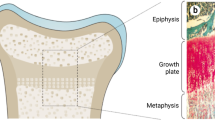Abstract
Osteopoikilosis and the Buschke-Ollendorff syndrome are skeletal dysplasias with hyperostotic lesions in the long bones. These disorders are caused by heterozygous loss-of-function mutations in the LEMD3 gene. LEMD3 codes for a protein of the inner nuclear membrane that, through interaction with R-SMADs, antagonizes the BMP and TGFβ1 pathway. It is suggested that the hyperostotic lesions in these disorders are caused by enhanced BMP and TGFβ1 signaling. The exact mechanism by which mutations in the LEMD3 gene lead to these bone lesions has not yet been unraveled precisely. To further assess this, an Lemd3 gene–trapped mouse was created in a gene-trapping program by Baygenomics. To investigate whether the heterozygous gene-trapped mouse is a good model for osteopoikilosis in humans, we studied these mice radiologically with high-resolution micro-computed tomography (microCT) and histologically. X-ray images were evaluated by a trained radiologist, but no typical osteopoikilosis lesions could be recognized. On all microCT reconstructed images a 3D cortical and trabecular quantitative analysis was performed, investigating different histomorphometric parameters ranging from percent bone volume, bone surface/volume ratio over trabecular thickness, separation, number, and pattern factor to structure model index and fractal dimension. No significant differences were found after a t-test statistical analysis. Also, histological analysis did not reveal lesions typical for osteopoikilosis. We conclude that the heterozygous Lemd3 gene–trapped mouse is not a good model to study osteopoikilosis and the Buschke-Ollendorff syndrome.


Similar content being viewed by others
References
Lagier R, Mbakop A, Bigler A (1984) Osteopoikilosis: a radiological and pathological study. Skeletal Radiol 11:161–168
Hellemans J, Preobrazhenska O, Willaert A, Debeer P, Verdonk PC, Costa T, Janssens K, Menten B, Van Roy N, Vermeulen SJ, Savarirayan R, Van Hul W, Vanhoenacker F, Huylebroeck D, De Paepe A, Naeyaert JM, Vandesompele J, Speleman F, Verschueren K, Coucke PJ, Mortier GR (2004) Loss-of-function mutations in LEMD3 result in osteopoikilosis, Buschke-Ollendorff syndrome and melorheostosis. Nat Genet 36:1213–1218
Paulin-Levasseur M, Blake DL, Julien M, Rouleau L (1996) The MAN antigens are non-lamin constituents of the nuclear lamina in vertebrate cells. Chromosoma 104:367–379
Lin F, Blake DL, Callebaut I, Skerjanc IS, Holmer L, McBurney MW, Paulin-Levasseur M, Worman HJ (2000) MAN1, an inner nuclear membrane protein that shares the LEM domain with lamina-associated polypeptide 2 and emerin. J Biol Chem 275:4840–4847
Wagner N, Krohne G (2007) LEM-domain proteins: new insights into lamin-interacting proteins. Int Rev Cytol 261:1–46
Lin F, Morrison JM, Wu W, Worman HJ (2005) MAN1, an integral protein of the inner nuclear membrane, binds Smad2 and Smad3 and antagonizes transforming growth factor-beta signaling. Hum Mol Genet 14:437–445
Pan D, Estevez-Salmeron LD, Stroschein SL, Zhu X, He J, Zhou S, Luo K (2005) The integral inner nuclear membrane protein MAN1 physically interacts with the R-Smad proteins to repress signaling by the transforming growth factor-β superfamily of cytokines. J Biol Chem 280:15992–16001
Ishimura A, Ng JK, Taira M, Young SG, Osada S (2006) Man1, an inner nuclear membrane protein, regulates vascular remodeling by modulating transforming growth factor beta signaling. Development 133:3919–3928
Cohen TV, Kosti O, Stewart CL (2007) The nuclear envelope protein MAN1 regulates TGFbeta signaling and vasculogenesis in the embryonic yolk sac. Development 134:1385–1395
Parfitt AM, Drezner MK, Glorieux FH, Kanis JA, Malluche H, Meunier PJ, Ott SM, Recker RR (1987) Bone histomorphometry: standardization of nomenclature, symbols, and units. Report of the ASBMR Histomorphometry Nomenclature Committee. J Bone Miner Res 2:595–610
Montero A, Okada Y, Tomita M, Ito M, Tsurukami H, Nakamura T, Doetschman T, Coffin JD, Hurley MM (2000) Disruption of the fibroblast growth factor-2 gene results in decreased bone mass and bone formation. J Clin Invest 105:1085–1093
Liu J, Lee KK, Segura-Totten M, Neufeld E, Wilson KL, Gruenbaum Y (2003) MAN1 and emerin have overlapping function(s) essential for chromosome segregation and cell division in Caenorhabditis elegans. Proc Natl Acad Sci USA 100:4598–4603
Callewaert BL, Loeys BL, Casteleyn C, Willaert A, Dewint P, De Backer J, Sedlmeier R, Simoens P, De Paepe AM, Coucke PJ (2008) Absence of arterial phenotype in mice with homozygous slc2A10 missense substitutions. Genesis 46:385–389
Rosati R, Horan GS, Pinero GJ, Garofalo S, Keene DR, Horton WA, Vuorio E, de Crombrugghe B, Behringer RR (1994) Normal long bone growth and development in type X collagen-null mice. Nat Genet 8:129–135
Aszodi A, Bateman JF, Hirsch E, Baranyi M, Hunziker EB, Hauser N, Bosze Z, Fassler R (1999) Normal skeletal development of mice lacking matrilin 1: redundant function of matrilins in cartilage? Mol Cell Biol 19:7841–7845
Acknowledgements
Heterozygous Lemd3 +/GT mice were kindly provided by S. G. Young (UCLA, Los Angeles). This study was supported by the Research Foundation–Flanders (Belgium, grant 3G027907), the Ghent University, the Sixth Framework of the European Commission (EuroGrow project LSHM-CT-2007-037471), and the Institute for Broad Band Technology. J. H. is a postdoctoral fellow and G. M. is a senior clinical investigator of the Research Foundation–Flanders.
Author information
Authors and Affiliations
Corresponding author
Rights and permissions
About this article
Cite this article
Dheedene, A., Deleye, S., Hellemans, J. et al. The Heterozygous Lemd3 +/GT Mouse Is Not a Murine Model for Osteopoikilosis in Humans. Calcif Tissue Int 85, 546–551 (2009). https://doi.org/10.1007/s00223-009-9305-z
Received:
Accepted:
Published:
Issue Date:
DOI: https://doi.org/10.1007/s00223-009-9305-z




